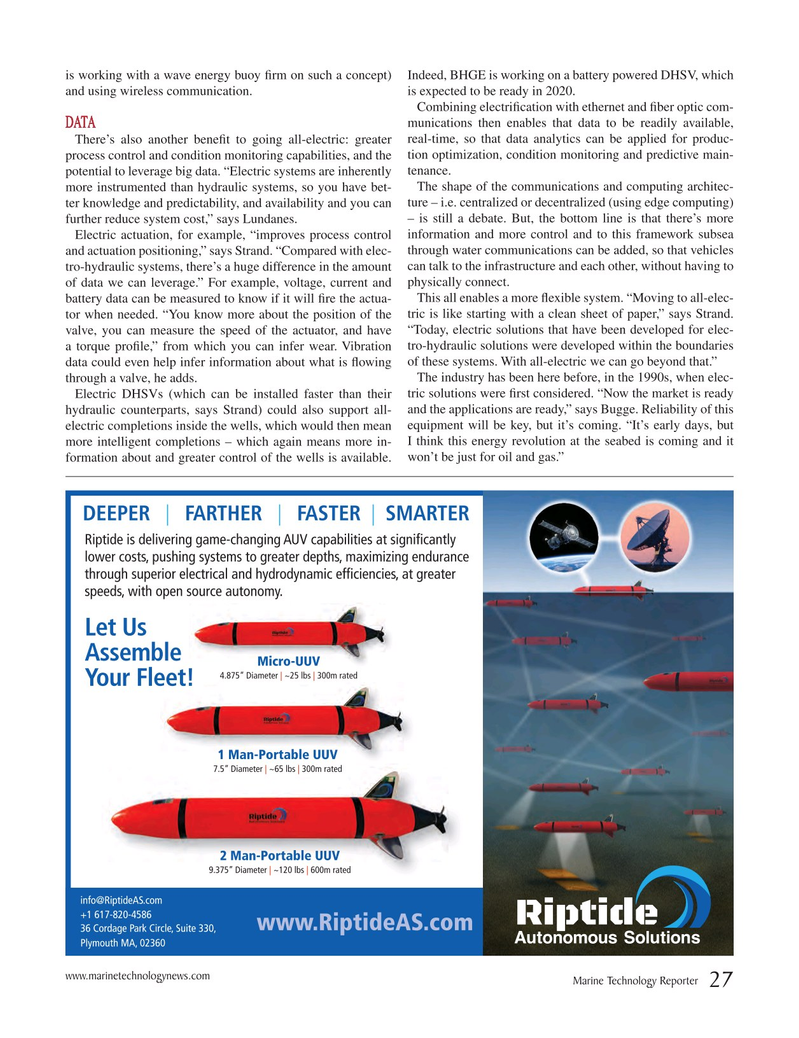
Page 27: of Marine Technology Magazine (May 2018)
Hydrographic Survey: Single beam and Multibeam Sonar
Read this page in Pdf, Flash or Html5 edition of May 2018 Marine Technology Magazine
is working with a wave energy buoy ? rm on such a concept) Indeed, BHGE is working on a battery powered DHSV, which and using wireless communication. is expected to be ready in 2020.
Combining electri? cation with ethernet and ? ber optic com- munications then enables that data to be readily available,
DATA
There’s also another bene? t to going all-electric: greater real-time, so that data analytics can be applied for produc- process control and condition monitoring capabilities, and the tion optimization, condition monitoring and predictive main- potential to leverage big data. “Electric systems are inherently tenance. more instrumented than hydraulic systems, so you have bet- The shape of the communications and computing architec- ter knowledge and predictability, and availability and you can ture – i.e. centralized or decentralized (using edge computing) further reduce system cost,” says Lundanes. – is still a debate. But, the bottom line is that there’s more
Electric actuation, for example, “improves process control information and more control and to this framework subsea and actuation positioning,” says Strand. “Compared with elec- through water communications can be added, so that vehicles tro-hydraulic systems, there’s a huge difference in the amount can talk to the infrastructure and each other, without having to of data we can leverage.” For example, voltage, current and physically connect. battery data can be measured to know if it will ? re the actua- This all enables a more ? exible system. “Moving to all-elec- tor when needed. “You know more about the position of the tric is like starting with a clean sheet of paper,” says Strand. valve, you can measure the speed of the actuator, and have “Today, electric solutions that have been developed for elec- a torque pro? le,” from which you can infer wear. Vibration tro-hydraulic solutions were developed within the boundaries data could even help infer information about what is ? owing of these systems. With all-electric we can go beyond that.” through a valve, he adds. The industry has been here before, in the 1990s, when elec-
Electric DHSVs (which can be installed faster than their tric solutions were ? rst considered. “Now the market is ready hydraulic counterparts, says Strand) could also support all- and the applications are ready,” says Bugge. Reliability of this electric completions inside the wells, which would then mean equipment will be key, but it’s coming. “It’s early days, but more intelligent completions – which again means more in- I think this energy revolution at the seabed is coming and it formation about and greater control of the wells is available. won’t be just for oil and gas.”
DEEPER | FARTHER | FASTER | SMARTER
Riptide is delivering game-changing AUV capabilities at signif cantly lower costs, pushing systems to greater depths, maximizing endurance through superior electrical and hydrodynamic eff ciencies, at greater speeds, with open source autonomy.
Let Us
Assemble
Micro-UUV 4.875” Diameter | ~25 lbs | 300m rated
Your Fleet!
1 Man-Portable UUV 7.5” Diameter | ~65 lbs | 300m rated 2 Man-Portable UUV 9.375” Diameter | ~120 lbs | 600m rated [email protected] +1 617-820-4586 www.RiptideAS.com 36 Cordage Park Circle, Suite 330,
Plymouth MA, 02360 www.marinetechnologynews.com
Marine Technology Reporter 27
MTR #4 (18-33).indd 27 MTR #4 (18-33).indd 27 5/10/2018 8:54:30 AM5/10/2018 8:54:30 AM

 26
26

 28
28
